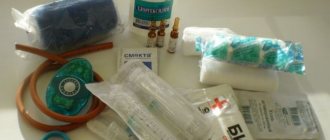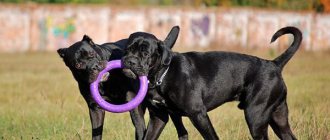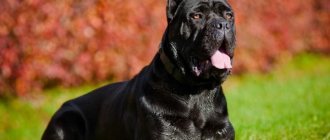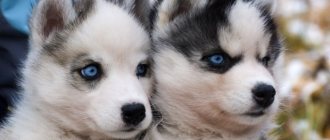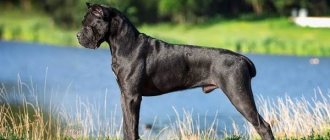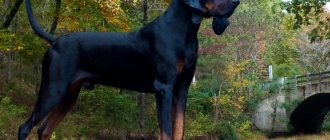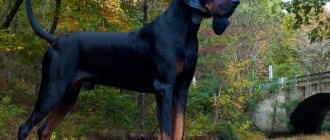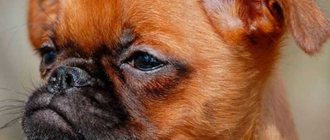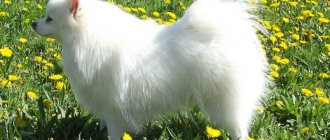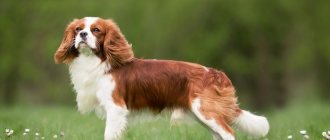The brindle Cane Corso looks very attractive, the dog is powerful and muscular in appearance, and is especially popular with owners of elite guard dogs.
Just because of its appearance, it can scare away an ill-wisher.
The Cane Corso is a born bodyguard; he will never leave his owner and will protect him to the end. And the stateliness and aristocratic appearance makes the breed especially popular.
In the article we will talk about the characteristics of dogs of this breed, and also show their photos.
What is color and suit in dogs
Color is the visible pigment of the outer part of the hair. In the absence of such pigment, the hair will remain white. In addition, the concept includes the intensity of the shade and the pattern created on the surface of the pet. If several colors are mixed, then the color that occupies most of the dog’s body will be called the suit.
Japanese Akita (Akita Inu)
The breed was bred in the province of Akita (Honshu Island), which is why it got its name. Akita Inu is recognized as a national treasure of Japan, its natural monument.
The breed, as a symbol of loyalty and devotion, became world famous thanks to the film “Hachiko: The Most Faithful Friend” directed by L. Hallström.
Akita is a quiet breed of dog: they bark only when necessary to warn the owner of danger.
This is an unusual and spectacular breed: dexterous, beautiful, stately, intelligent, and has an excellent memory. The animal is child friendly. She treats other pets calmly if she was raised next to them.
The Akita is unpretentious in its maintenance: it is happy with both an apartment and a private house.
The breed standard provides the following parameters: height for males - 67 centimeters, females - 61 centimeters, weight from 40 to 50 kilograms. Three types of color are allowed: red and white, brindle and white, pure white.
Life expectancy is 10–12 years.
To help your pet get rid of dying fur, it needs to be combed once a week; when shedding, the number of combings needs to be increased to three to four times a week.
Akita was bred as a guard and hunting dog. She swims well, and the waterproof undercoat allows the coat to remain dry.
Animal training must begin at 3–4 months. Since the Akita has a possessive and hunting instinct, it requires early socialization. The strong will and capricious nature of the dog will require patience and rigor from the owner in raising the pet.
The breed is not recommended for beginners in dog breeding. Suitable for people who have experience in keeping large dogs, have a strong character and lead an active lifestyle.
Color groups
Experts divided all the variety of colors into several main groups. They include both single-color and multi-color variations of shades and patterns.
Solid
The solid color of tetrapods is distinguished by the presence of only one shade on their body. On the other hand, it may be its complete absence. The substance eumelanin forms black or chocolate pigmentation with varying degrees of saturation. The lightened form of this type is called blue or beige.
The substance pheomelanin is responsible for the red or deer variant. And the lightened form of the pigment gives a sandy background with variations from white to light cream.
Mixed
A mixed group appears by combining a pair of shades. Moreover, the white tone should not participate in the mixing. The variation in the colors of the dog is influenced by the presence of the substance eumelanin or pheomelanin. As a result of the manifestation of these two pigments, 5 types of mixed tones are distinguished:
- red with a black mask on the face;
- red with some darkening;
- brindle;
- black with reddish tan;
- red with black undertones.
All types of these variations are characterized by some lightening and a special placement of pigmented fur on the body of the four-legged friend. The mask, in turn, is combined with each of the four tones.
Modified
The mentioned groups may change with age. So, spots, bleached or piebald areas appear on the fur. However, lightened dog coat color is common in many breeds, and this is in no way due to age-related changes. It’s just that a pet is born with pigment, but over time it loses it.
This modification can be observed in combination with any base tone. For example, dark spots or variegated shades are clearly visible against gray and lightened backgrounds. This is the so-called marble tone.
White spots are formed due to a complete lack of pigmentation on certain parts of the pet’s body. There are pets that have white spots located almost all over their body, and only their ears are colored.
How to choose a puppy
To get a pet of a certain color, the owner must pay attention to the puppy's parents. The cub will definitely inherit the appearance of one or two ancestors, so it must be taken into account. For example, if a silver tint to the coat is undesirable, then it is better not to buy a puppy from such a parent. A dog's appearance can change with age. This is how modified colors manifest themselves.
Of course, his appearance is unlikely to affect his love for his pet. However, it is important to choose the color carefully if the dog is to continue its purebred lineage.
The puppy's coat color depends on the coat color of the parents.
In order not to make a mistake with the choice, breeders have drawn up several rules to help “predict” the future appearance of the pet:
| Puppy appearance | Forecast for the future |
| The cub has a hard coat structure | An adult dog will have short hair |
| Fur fluffed up like cotton wool | In the future - unclear color lines, dull fur, lack of shine |
| Subtle waves in the hair structure | Over time, a pale silver teak will appear |
| Silky "plumage" | The puppy will have a uniform color and correct fur structure |
Single-color dog colors with shade names
Individuals of the same color are found in different breeds. There are quite a lot of them, so they delight you with rich tones and interesting solutions. Specialists in the selection and breeding of four-legged animals have created a classification of individuals with uniformly colored fur.
All monochromatic representatives are divided into:
- Dark
, which are influenced by the substance eumelanin. The saturation of the dog's color depends entirely on the concentration of this pigment. A high content of eumelanin was noted in dark brown and black individuals. Some breeders say that there is no such thing as a black dog, but that it is simply a highly concentrated shade of dark brown.
- Svetlykh
, whose fur was colored with pheomelanin. A high concentration of this element in the hairs of the animal gives them a yellow and deer tint. A slight pigmentation with pheomelanin makes the pet's fur sandy.
- Reds
, which include light reddish and deep red coats. The main tone of this option is red. The mahogany look is now popular, incorporating the brightness and richness of red.
- Apricotsovs
, which are considered just an intermediate step between cream and red options. This species has some degree of whitishness and is distinguished from the red one by inclusions of light hairs.
- Blue
– this option includes silver and gray fur. Individuals with blue fur are distinguished by an ash-light or dark shade.
- Isabellovs
, or weakened brown. This is a pinkish-cream version with gray or blue tints. The variant is obtained by mixing blue and red colors.
- Belykh
individuals who received such a coat at birth. Snow-white pets have black or brown noses and lips.
- Palevykh
, having a lightened red color. The fawn color of dogs can have different shades. Thus, the area of the chest, paws and the lower part of the tail can be almost white, and the mask on the face, on the contrary, is dark or even black. Fawn-colored dogs differ in the tone of their nose: it can be pink, brown or dark.
This classification of monochromatic individuals gradually becomes more complicated, supplemented by other options. So, recently they began to talk about albinos, whose fur looks snow-white. In fact, the fur coat of albinos is colorless, and the lips and nose of the unusual animal are painted white. In nature, there are very few true owners of such wool.
Appearance
The interesting Japanese tiger dog is of medium size, has a strong, well-proportioned body, and well-developed muscles. The head of the animal is quite large, the skull is wide. The transition from the forehead to the muzzle is clearly defined. The dog's muzzle is medium, quite voluminous. The nose is black. The dog's jaws are powerful, and the lips fit quite tightly. Cheekbones are well developed. The eyes are small, triangular, dark brown.
The ears of representatives of the breed are erect, medium, triangular, directed straight forward. The neck is of medium length, powerful, muscular. The back is short and straight. The loin is strong and wide. The pet's chest is deep and quite wide. The stomach is taut. The limbs are strictly straight, strong, and muscular. The paws are powerful, the toes are closed, the pads are thick, the nails are dark and strong. The fur is hard, sticking out, straight, the undercoat is dense and soft. The color of the animal is brindle.
The main fur colors include:
Two-color varieties
The combination of two different shades on the body of a four-legged friend allowed breeders and zoologists to talk about a large number of variations. These include quite common types, and those combinations that are difficult to find on an ordinary dog.
Tan
The main tone of this option is gray, brown or dark. The tan color of dogs is distinguished by light spots that sharply border on the main tone. Tan is located on the eyebrows in the form of two spots, on the cheekbones, throat and chest area. There are lightened areas on the muzzle, but in this case the bridge of the nose has the main pigmentation. Tan marks can be seen on the front of the animal's paws, around the anus, and on the bottom of the tail.
Zonar, or wolf
The zonal or wolf version of the two-color color has a light background. At the same time, in certain areas of the animal’s body, yellow, black and lightened areas are clearly visible.
Cheprachny
The basis of a dog’s saddle fur is a red pigment, which gives the pet’s fur coat different shades - from bright red to light fawn. In addition, black or gray becomes the main tone.
The sable color of dogs differs in size and tone. Most often, darker areas are located on the upper part of the animal’s body: on the head, shoulders, back, tail. Lighter pigmentation occurs on the lower jaw, cheeks, throat, chest, and belly.
Sable
The coat of pets with the sable color variant is characterized by a predominance of a reddish tint of varying degrees of saturation. The ends of the hair of such representatives contain a special pigment that colors them black.
brindle
The brindle color in dogs appears as transverse dark stripes on brown or sandy fur. The body of the animals is painted in warm shades: yellow, red, red. There may be gray fur, but it is very rare.
Sometimes the presence of whitish points is noticeable, which is not considered a flaw. The stripes on the dog's body look like rings that break on the stomach. A dark, almost black mask is often visible on the face of a tiger pet.
Murugiya
This option takes as a basis a dark red shade, which varies, reaching the darkest color of mahogany. The ends of the pet's hair are covered in a dark, almost black tone. The nut color, which is called fawn, is also found here. It can range from light sandy to dark golden in tone. Redness is not typical for this species.
Origin
It is believed that the Dutch Shepherd is an intermediate link between the Belgian Shepherd and the German Shepherd. It appeared in the 18th century, but Dutch dog lovers ignored this breed for some time, fascinated by promising German shepherds. Herder was used for a long time simply as a shepherd dog, he coped with his duties perfectly. Only at the end of the 19th century was this hardworking rural dog finally remembered. Herders began to be recruited for service in the police and military department. Before the First World War, they completely replaced the German Shepherds in Holland.
Three-color variations
A tricolor dog acquires its color as a result of a mixture of tan or saddleback species combined with black or red spots. Moreover, the marks are placed in strictly defined areas of the body, and not in a chaotic manner. Among these variations are:
- Roan
, the peculiarity of which is the location between pigmented hairs of non-pigmented (that is, white). This combination creates a silvery background with some weakening.
- Marble
, or "Harlequin", with a white, blue-gray or light base. The dog has black spots with jagged edges. Sometimes the marks may have a brownish-gray tint.
- Piebald
, which is a combination of two bases. This option appears in large light or white spots. They are located on a reddish background. In some cases, the base tone has a different pigment.
The names of colors vary among different breeds. These may be traditional specific names. There are also special names for the colors of hunting animals, which have historically developed and become entrenched in the everyday life of lovers of four-legged animals.
Content
The picky Dutch Shepherd easily adapts to any conditions and tolerates cold and heat well. The closed area of a private country house is best suited for it. It is not recommended to keep her in an enclosure or on a leash.
The Herder will get bored indoors. The dog needs a lot of physical activity. In urban environments, you will have to walk your Herder for at least 5 hours, allowing him to run and play. During a walk, the dog does not move far from the owner, preferring to describe circles around him, guarding him.
See also: Mongolian Shepherd Bankhar
What to feed
During puppyhood, the Herder is prone to overeating. It is necessary to feed the animal strictly at a certain time and control the amount of food consumed. An adult Herder is fed 1 – 2 times a day.
The Herder's coat does not require any special care; brushing once every two days is sufficient. The Wirehaired Herder needs to be trimmed twice a year, otherwise there may be problems with the coat.
You shouldn't wash the header often. If the wool is dirty, it is enough to rinse the contaminated areas with running water without shampoo.
Types by location of spots
The appearance and location of the marks on the dog’s body differ in intensity and size. They can cover almost the entire body of the animal or concentrate in certain areas. Dogs with spots on their coats come in most breeds. Based on the location of the spots, they are distinguished:
- Irish spot with white markings of varying sizes that cover most of the animal's body.
- Piebald, in which there are large white areas on the head, neck, chest, tail and paws against a dark background.
- Extreme spotting with a small amount of primary color pigment. Sometimes the pet appears white with small colored areas.
- Speckling, when many small spots are visible on a white or light gray tone, the color of which depends on the main color of the dog.
- Marble with black spots of irregular geometry and different sizes on a white base.
Some breeds begin to develop a spotted pattern as they age. For example, the fur of Dalmatians only after two months of life becomes similar to the standard exterior that is familiar to people. Sometimes the appearance of spotting is associated with deviations from the characteristics of the breed.
History of the breed
The brindle Cane Corso, like other dogs of this breed, comes from an ancient Italian family. There are references to dogs in sources about the Ancient Roman Empire.
NOTE!
The ancestors of these dogs began to be brought to Greece and Italy during the period of particular popularity of gladiator fights. Subsequently, animals of this breed, in addition to their gladiatorial purpose, began to be used by hunters and farmers as guards and for catching wild animals.
The next mention of this species dates back to the Middle Ages, when gladiator dogs changed their occupation and became service dogs.
Now they were no longer popular with the nobility, but served only the needs of the peasants, faithfully guarding their herds and fields.
After World War II, Cane Corsos were on the verge of death. Only thanks to a small group of people, this beautiful breed was preserved and exists to this day.
Varieties of face masks
Different breeds of four-legged animals differ not only in the color of their coat, but also in other features of their exterior. Thus, on the dogs’ faces you can see masks characteristic of the breeds.
They are dark - brown or gray. Masks may vary in size and extend to the chest. The marking is combined with a variety of bases: zoned, saddle, tan and brindle. And among greyhounds the mask is called “mazurina”.
Reverse masks are light areas on the dog's face. May be called domino or grizzly. The reverse mask is combined with zonal and saddle tones.
Refreshing kitchen cleaner
What you will need:
- 4 tablespoons of soda;
- a little less than a liter of warm water.
This simple mixture will help refresh the kitchen - clean different surfaces and even the inside of the refrigerator. To remove odors from your trash can and sink or bathtub drain, you can take just baking soda and pour it straight from the box, then rinse off the residue with water.
If you need to clean something made of stainless steel, it is better to mix the ingredients to a paste, use a damp cloth and gently rub the mixture in the direction of the metal texture, then immediately rinse with water and let the surface dry.
The rarest types and tones of dog colors
There are rare color variants that are found only in some breeds. For example, Blenheim combines the mottled hue of rich chestnut with a pearly white background. This type of coat is typical for Cavalier King Charles Spaniels. This breed has a white diamond-shaped pattern on the crown of their head.
Pit bulls, bull terriers, corgis, Aussies and other breeds have a rare type of color called merle. This is uneven pigmentation of the coat. Merle appears as a combination of the same dark or light background.
Merle is rare, since the gene responsible for this coloring carries deviations in health. It is prohibited for breeding in most breeds.
Character
Herder is a herding dog, its distinctive qualities are:
- Courage;
- Endurance;
- Devotion;
- Flexibility;
- Mobility;
- Distrust of strangers;
- Reliability;
- Mind.
Having an adequate character, the Dutch Shepherd does not bark for no reason and does not rush at people. If there is a threat, the Herder will not leave its owner and will scare away the enemy by barking. A dog will attack only if there is a mortal threat to the owner. A dog's aggression can also be provoked by a drunk person.
Relationships with other pets
The Herder rarely conflicts with other dogs and gets along well with pets. The genes of a shepherd dog have an effect - he perceives the owner’s family and his pets as a herd that needs to be protected.
Relationships with children
Herder is good with children and loves to play with them. The patient Dutch Shepherd is tolerant of being pulled by its tail or other parts of its body.
Genetic conditioning
The appearance of the fur of tetrapods is determined by different genes. Some of them are responsible for the fusion of the substances eumelanin and pheomelanin. Other genes distribute these elements throughout the pet's coat and body.
There is a hereditary predisposition that determines the intensity of the basic tone and spottiness of the fur. The main genes responsible for the tone of the coat are genes A, C, B, D, E, G, M.
Their combination forms the color and pattern on the body of the four-legged friend. Genes are able to combine in different combinations, distributing pigment and spotting throughout the body. Experienced breeders, having seen the parents of the future puppy, are able to calculate the baby’s exterior, even if he is still in the womb.
The standards of some breeds contain strict rules on genetic conditioning. For example, in Europe there is a ban on dogs with Isabella color. This variant contains a combination of genes that subsequently provoke a whole range of diseases.
Our conclusions
Today we discussed the peculiarities of the structure of the coat of dogs, learned about what color is, what colors they are, what they are. Perhaps a discovery for someone was that as animals grow older, the color of animals changes and now, when you choose a puppy, you will pay attention to this aspect. We also looked at how color affects the character of the animal. We hope you find all this information useful. If you still have questions, we will be happy to answer them. Ask them on the website or in our VKontakte group.
By the way, what color is the dog living in your house? What is her temperament? Why don't we together determine the most popular color of dogs among readers of our site? We are waiting for your comments and answers. And, our next publication will dedicate you to the topic of breed diseases of these animals...
